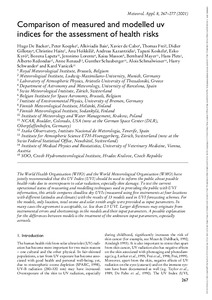Por favor, use este identificador para citar o enlazar este ítem:
http://hdl.handle.net/20.500.11765/14369
Comparison of measured and modelled uv indices for the assessment of health risks
Registro completo de metadatos
| Campo DC | Valor | Lengua/Idioma |
|---|---|---|
| dc.contributor.author | Backer, Hugo de | es_ES |
| dc.contributor.author | Koepke, Peter | es_ES |
| dc.contributor.author | Bais, Alkiviadis F. | es_ES |
| dc.contributor.author | Cabo, Xavier de | es_ES |
| dc.contributor.author | Frei, Thomas | es_ES |
| dc.contributor.author | Gillotay, Didier | es_ES |
| dc.contributor.author | Haite, Christine | es_ES |
| dc.contributor.author | Heikkilä, Anu | es_ES |
| dc.contributor.author | Kazantzidis, Andreas | es_ES |
| dc.contributor.author | Koskela, Tapani | es_ES |
| dc.contributor.author | Kyrö, Esko | es_ES |
| dc.contributor.author | Lapeta, Bozena | es_ES |
| dc.contributor.author | Lorente, Jerónimo | es_ES |
| dc.contributor.author | Masson, Kaisa | es_ES |
| dc.contributor.author | Mayer, Bernhard | es_ES |
| dc.contributor.author | Plets, Hans | es_ES |
| dc.contributor.author | Redondas, Alberto | es_ES |
| dc.contributor.author | Renaud, Anne | es_ES |
| dc.contributor.author | Schauberger, Gunther | es_ES |
| dc.contributor.author | Schmalwieser, Alois | es_ES |
| dc.contributor.author | Schwander, Harry | es_ES |
| dc.contributor.author | Vanicek, Karel | es_ES |
| dc.date.accessioned | 2023-02-13T11:15:01Z | - |
| dc.date.available | 2023-02-13T11:15:01Z | - |
| dc.date.issued | 2001 | - |
| dc.identifier.citation | Meteorological Applications. 2001, 8(3), p. 257-384 | es_ES |
| dc.identifier.issn | 1350-4827 | - |
| dc.identifier.issn | 1469-8080 | - |
| dc.identifier.uri | http://hdl.handle.net/20.500.11765/14369 | - |
| dc.description.abstract | The World Health Organisation (WHO) and the World Meteorological Organisation (WMO) have jointly recommended that the UV Index (UVI) should be used to inform the public about possible health risks due to overexposure to solar radiation, especially skin damage. To test the current operational status of measuring and modelling techniques used in providing the public with UVI information, this article compares cloudless sky UVIs (measured using five instruments at four locations with different latitudes and climate) with the results of 13 models used in UVI forecasting schemes. For the models, only location, total ozone and solar zenith angle were provided as input parameters. In many cases the agreement is acceptable, i.e. less than 0.5 UVI. Larger differences may originate from instrumental errors and shortcomings in the models and their input parameters. A possible explanation for the differences between models is the treatment of the unknown input parameters, especially aerosols. | es_ES |
| dc.language.iso | eng | es_ES |
| dc.publisher | Wiley Open Access | es_ES |
| dc.publisher | Royal Meteorological Society | es_ES |
| dc.rights | Licencia CC: Reconocimiento–NoComercial–SinObraDerivada CC BY-NC-ND | es_ES |
| dc.subject | UV Index | es_ES |
| dc.subject | Health risks | es_ES |
| dc.subject | Solar radiation | es_ES |
| dc.subject | Skin damage | es_ES |
| dc.title | Comparison of measured and modelled uv indices for the assessment of health risks | es_ES |
| dc.type | info:eu-repo/semantics/article | es_ES |
| dc.relation.publisherversion | https://doi.org/10.1017/S1350482701003024 | es_ES |
| dc.rights.accessRights | info:eu-repo/semantics/openAccess | es_ES |
| Colecciones: | Artículos científicos 2000-2004 | |
Ficheros en este ítem:
| Fichero | Descripción | Tamaño | Formato | ||
|---|---|---|---|---|---|
| MA_Backer_2001.pdf | 844,9 kB | Adobe PDF |  Visualizar/Abrir |
Los ítems de Arcimis están protegidos por una Licencia Creative Commons, salvo que se indique lo contrario.





